Luxor Tourist Attractions and Sightseeing
(Luxor, Egypt)
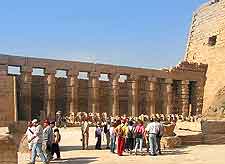
Blessed with a wealth of fascinating historic tourist attractions, Luxor is the ideal holiday destination for anyone with an interest in the ancient civilisation of Egypt.
Luxor is also perfect for tourists who simply appreciate the aesthetic properties of architectural wonders and attractions, which have been a part of the region for several millennia.
Ancient temples and tombs provide visitors staying in the area with some fantastic photo opportunities.
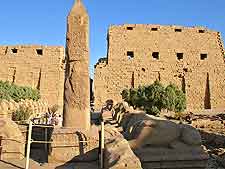
Temple of Karnak
Known as Ipet-isut by the ancient Egyptians, the Temple of Karnak is in fact a whole city of temples that were constructed over two millennia ago and were originally made in tribute to the Theben triad of Amon, Mut and Khonsu. Within easy reach of central Luxor, this entire ancient city covers some 200 acres / 120 hectares, with the many attractions at the Amon enclosure alone covering a massive 60 acres / 36 hectares. The biggest temple at the heart of the city is awesome and so big that the cathedrals of Notre Dame, St. Peter's and Milan would be lost within its spacious confines. The 54,000 square-foot Hypostyle Hall has a total of 134 columns and is hailed as the largest room within a religious building anywhere in the world.
Open hours: call for details
Admission: charge
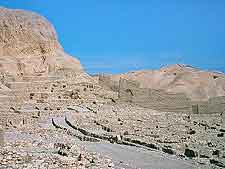
Deir el-Medina
Otherwise known as the Artisan Village, Deir el-Medina is close to central Luxor and is the remains of an old Egyptian township that was previously inhabited by various craftsmen following its founding by Tuthmose I. The craftspeople who called this town home were responsible for decorating the tombs in the Valley of the Kings. Little or nothing is left of the original town except the stone walls which ran its perimeter and marked out streets and houses. Attractions at Deir el-Medina include two tombs within the town, which house the remains of some of the workers and also contain some interesting wall paintings.
Open hours: call for details
Admission: charge
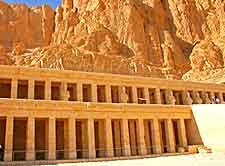
Temple of Deir El-Bahri
Also known as the Temple of Queen Hatshepsut, Luxor's Temple of Deir El-Bahri is one of the country's most distinctive and characteristic temples on account of both its architectural design and decoration. The temple was built in limestone (unlike others which are made from sandstone) and was the work of the famous Egyptian architect Senimut. It was constructed for the great Queen Hatshepsut of the 18th Dynasty as her funerary temple.
Open hours: call for details
Admission: charge
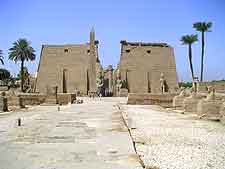
Temple of Luxor
The Temple of Luxor was built largely by King Ramesses II and King Amenhotep III and was constructed with the intention of being the focal point of the city's most popular festival, known as the Festival of Opet. This grand temple is a magnificent structure with many separate sections, each of which was designed with a specific purpose in mind with regards to the festival. Some of the most famous buildings and attractions include the Pylons, Court of Ramesses II, Mosque of Abu'l Haggag and the Court of Amenhotep II.
Open hours: call for details
Admission: charge
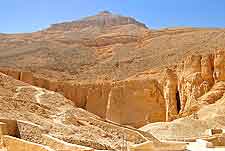
Valley of the Kings
While the Valley of the Kings is considerably less grand than the Pyramids in terms of Egyptian funerary complexes, it is still well worth a visit and is amongst Luxor's most-visited tourist attractions. The Valley of the Kings illustrates some aspects of the Egyptian concept of the afterlife that the Pyramids do not. Some 30 to 40 tombs are open for visitor exploration, although it would be highly ambitious to expect to see so many and taking a look around five is usually sufficient for most tourists. Among the more popular tombs are those of Ramesses IV, Ramesses IX, Merneptah and Ramesses VI.
Open hours: call for details
Admission: charge
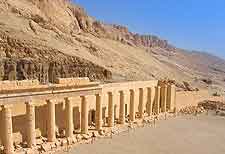
Valley of the Queens
This fascinating historical Luxor attraction is the last resting place of the wives and children of the Pharaohs from the 18th, 19th and 20th dynasties. There are allegedly over 70 burial sites located within the Valley of the Queens, the most famous of which is the tomb of Queen Nefertiti (unfortunately closed now). The Tomb of Queen Tyti and the Tomb of Amenherkhepshef are however still open and among the top attractions of the valley. All visitors are required to wear masks and shoe pads when entering the tombs.
Open hours: call for details
Admission: charge
 Blessed with a wealth of fascinating historic tourist attractions, Luxor is the ideal holiday destination for anyone with an interest in the ancient civilisation of Egypt.
Blessed with a wealth of fascinating historic tourist attractions, Luxor is the ideal holiday destination for anyone with an interest in the ancient civilisation of Egypt.




